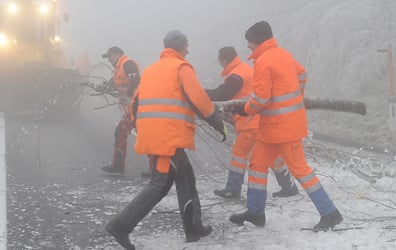Many roads in Lower Austria have been closed due to dangerous, icy conditions. In Krems the municipalities of Lichtenau, Weinzirl am Walde, Albrechtsberg an der Großen Krems, Jaidhof, Gföhl and St. Leonhard am Hornerwald have been declared disaster zones. The fire service is working around the clock and has been called out 1,000 times since Friday.
Firefighters are only responding to life and death emergencies during the night as conditions in the dark are so dangerous. In the district of Krems more than 20 such missions were carried out in the early hours of Wednesday morning – mainly responding to fallen trees on major roads and problems with emergency generators.
In Wolfshoferamt a tree fell on a house but firefighters were able to rescue the owner of the house, despite considerable damage to the property.
Doctors in the Waldviertel have been particularly busy setting casts, due to the number of people who have slipped on ice and broken limbs.
Dozens of emergency generators have been set up to help homes currently without electricity and heating, after power cables were downed. “With the current low temperatures it’s especially dangerous for families with young children”, Stefan Zach from electricity company EVN said.
“The main problems are with the connections between our substations and transformer stations. In cases where we cannot repair the lines, because of fallen trees, we are bringing emergency generators to households,” he added.
Strong winds are forecast for the Waldviertel on Wednesday, which could cause ice-covered trees to fall.
People have been advised to avoid entering woodland areas, and to stay away from trees, telephone masts, and electricity cables.
Conditions are also bad around Wiener Neustadt, and access to the Hohe Wand mountain ridge has been blocked due to dangerous black ice. Some people in the area have had to leave their homes and are being cared for by a crisis team.
In Mattersburg, Burgenland the Landesstraße has been closed in the direction of Lower Austria. Around 100 people are effectively trapped in their homes until it reopens.




 Please whitelist us to continue reading.
Please whitelist us to continue reading.
Member comments